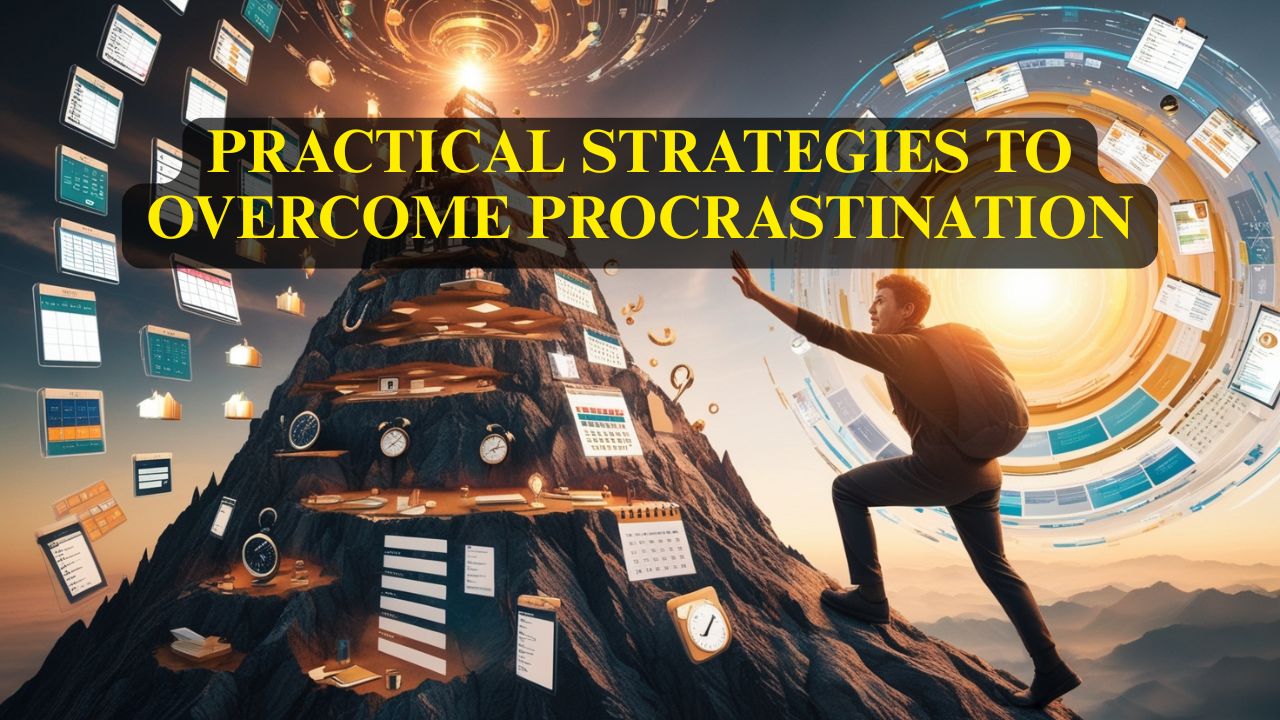Building Lasting Change: From Procrastinator to Productive
You now have a deep understanding of procrastination and a toolkit of strategies to combat it. But knowledge and techniques alone aren't enough—the real challenge lies in creating lasting change. This final article focuses on how to transform from someone who struggles with procrastination into someone who takes consistent, productive action.
Understanding the Change Process
Lasting change happens in stages, and understanding these stages helps you maintain realistic expectations and stay motivated:
Stage 1: Awareness (You've completed this)
- Understanding what procrastination really is
- Recognizing your personal patterns
- Identifying root causes
Stage 2: Preparation (You're here now)
- Developing strategies and tools
- Creating supportive environments
- Building motivation for change
Stage 3: Action
- Implementing new behaviors
- Practicing new responses to triggers
- Building new neural pathways through repetition
Stage 4: Maintenance
- Making new behaviors automatic
- Handling setbacks without giving up
- Continuing to grow and adapt
Stage 5: Integration
- New behaviors become natural and effortless
- Identity shifts from "procrastinator" to "person who takes action"
- Helping others who struggle with similar issues
The Habit Loop: Your Blueprint for Change
Every habit follows a simple loop: Cue → Routine → Reward. To change procrastination habits, you need to interrupt this loop:
Identify Your Cues
- Environmental triggers (messy desk, distracting location)
- Emotional states (anxiety, boredom, overwhelm)
- Time-based patterns (after lunch, Sunday evenings)
- Social situations (certain people or meetings)
Replace the Routine
Instead of your usual procrastination behavior, insert a productive routine:
- Take three deep breaths and identify one small next step
- Use the two-minute rule
- Apply the Pomodoro Technique
- Practice self-compassion and gentle redirection
Design the Reward
Your brain needs to experience benefit from the new behavior:
- Immediate rewards: checking items off a list, playing favorite music
- Progress rewards: visual progress tracking, sharing accomplishments
- Intrinsic rewards: sense of competence, reduced anxiety, self-respect
The 90-Day Transformation Plan
Research suggests it takes approximately 66 days to form a new habit, but complex behavioral changes like overcoming procrastination often take longer. Here's a structured 90-day approach:
Days 1-30: Foundation Building
- Focus on one primary strategy (choose your strongest from the previous article)
- Track your progress daily
- Practice self-compassion when you slip up
- Create environmental supports
- Goal: Build basic awareness and interrupt automatic patterns
Days 31-60: Expansion and Refinement
- Add 1-2 additional strategies
- Identify and address remaining obstacles
- Refine your approach based on what's working
- Start building accountability systems
- Goal: Develop a reliable system that works for your lifestyle
Days 61-90: Integration and Mastery
- Focus on making behaviors automatic
- Handle more complex or challenging situations
- Help others with similar struggles (teaching reinforces learning)
- Plan for long-term maintenance
- Goal: Transform identity from "procrastinator" to "person who takes action"
Creating Your Personal Action Plan
Step 1: Choose Your Core Strategies
Select 2-3 strategies from the previous article that resonated most strongly. Consider your lifestyle, personality, and primary procrastination triggers.
Step 2: Design Your Environment
- Remove or minimize triggers for procrastination
- Make productive behaviors easier
- Create visual reminders of your goals
- Establish a dedicated workspace
Step 3: Build Your Support System
- Identify people who can provide accountability
- Join communities of others working on similar goals
- Consider working with a coach or therapist if needed
- Create ways to track and celebrate progress
Step 4: Prepare for Obstacles
- Identify your highest-risk situations
- Create specific plans for handling setbacks
- Develop self-compassion practices
- Build in flexibility for life's inevitable disruptions
The Identity Shift
One of the most powerful aspects of lasting change is shifting your identity. Instead of thinking "I am a procrastinator who is trying to change," begin thinking "I am someone who takes action, and I'm still learning."
Language Changes That Support Identity Shifts:
- "I don't procrastinate" instead of "I'm trying not to procrastinate"
- "I take action on important things" instead of "I should stop procrastinating"
- "I'm learning to manage my time well" instead of "I'm bad at time management"
- "I handle difficult tasks systematically" instead of "I avoid hard things"
Handling Setbacks and Relapses
Setbacks are normal and expected. The difference between people who succeed long-term and those who don't isn't the absence of setbacks—it's how they respond to them.
When You Have a Setback:
- Acknowledge it quickly: Don't pretend it didn't happen or minimize it
- Avoid the shame spiral: One setback doesn't erase all progress
- Analyze what happened: What triggered the old behavior?
- Adjust your approach: What can you learn from this experience?
- Take immediate action: Do something small to get back on track
- Recommit: Reaffirm your commitment to change
The Comeback Formula:
Setback + Learning + Adjustment + Immediate Action = Stronger Progress
Building Intrinsic Motivation
External motivators (deadlines, pressure, rewards) can jumpstart change, but intrinsic motivation sustains it. Build intrinsic motivation by:
Connecting to Your Values
- Why does overcoming procrastination matter to you?
- How does productive action align with your deepest values?
- What becomes possible when you're not held back by procrastination?
Focusing on Growth
- Celebrate progress, not just outcomes
- View challenges as opportunities to strengthen your skills
- Embrace the learning process
Cultivating Autonomy
- Choose your own goals and methods
- Maintain flexibility in how you approach tasks
- Take ownership of your change process
Advanced Strategies for Long-Term Success
The Pre-Commitment Strategy
Make future procrastination more difficult by:
- Scheduling important tasks during your peak energy times
- Using apps that block distracting websites
- Creating financial stakes (donate to a cause you dislike if you don't follow through)
- Making public commitments
The Systems Approach
Instead of relying on motivation, create systems that make productive behavior automatic:
- Regular reviews of goals and progress
- Standardized routines for different types of tasks
- Checklists and templates for common activities
- Automated reminders and scheduling
The Continuous Improvement Mindset
- Regularly assess what's working and what isn't
- Experiment with new strategies and approaches
- Seek feedback from others
- Stay curious about your own behavior patterns
Maintaining Progress in Different Life Phases
Your anti-procrastination strategies may need to evolve as your life changes:
During High-Stress Periods
- Simplify your strategies to the most essential ones
- Lower your standards temporarily to maintain momentum
- Focus on stress management and self-care
- Use support systems more actively
During Major Life Transitions
- Expect temporary increases in procrastination
- Rebuild routines gradually
- Adapt strategies to new circumstances
- Be patient with yourself during adjustment periods
During Success and Growth
- Avoid complacency by setting new challenges
- Help others who are earlier in their journey
- Continue learning and refining your approach
- Celebrate your progress and transformation
Creating Your Legacy
As you overcome procrastination, you become a model for others. Consider how you can:
- Share your story and strategies with others
- Mentor someone who struggles with similar issues
- Create systems that help your family or team be more productive
- Continue growing and challenging yourself in new areas
Your Transformation Commitment
Take a moment to write down your commitment to change. Include:
- Why overcoming procrastination matters to you
- The specific strategies you'll start with
- How you'll track your progress
- What support you'll seek
- How you'll handle setbacks
Final Thoughts: From Procrastinator to Producer
You've embarked on a journey that goes far beyond simply getting things done. Overcoming procrastination is about becoming the person you want to be—someone who takes action, follows through on commitments, and creates the life they envision.
Remember that this transformation isn't about perfection. It's about progress, growth, and developing the skills to handle whatever challenges life presents. There will be setbacks, difficult days, and moments of doubt. That's not failure—that's part of the human experience.
What matters is that you now have the knowledge, tools, and framework to continue moving forward. You understand the psychology behind procrastination, you've identified your personal patterns, you know the root causes that drive your behavior, and you have a comprehensive toolkit of strategies to create lasting change.
Most importantly, you're no longer alone in this struggle. You're part of a community of people who understand that procrastination isn't a character flaw—it's a habit that can be changed with patience, understanding, and the right approach.
Your journey from procrastinator to productive person starts now. Take the first small step, then another, and another. Before you know it, you'll look back and realize that you've become exactly who you set out to be: someone who takes action and creates the life they want.
The time for waiting is over. Your productive life begins today.















